Nutley, New Jersey Revolutionary War Sites (original) (raw)
- HOME
- •
- TIMELINE
- •
- ABOUT
- •
- FAQ
- •
- READ THE BOOK!
This website, its text and photographs are © 2009 - 2025 AL Frazza. All rights reserved.
- Atlantic County
- Bergen County
- Burlington County
- Camden County
- Cape May County
- Cumberland County
- Essex County
- Gloucester County
- Hudson County
- Hunterdon County
- Mercer County
- Middlesex County
- Monmouth County
- Morris County
- Ocean County
- Passaic County
- Salem County
- Somerset County
- Sussex County
- Union County
- Warren County

NUTLEY REVOLUTIONARY WAR SOLDIERS MEMORIAL
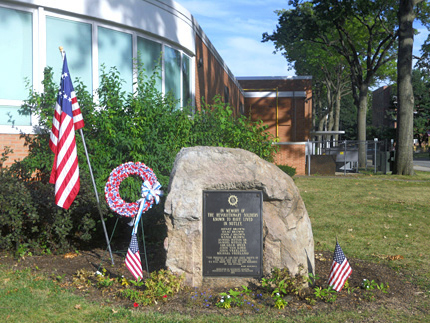
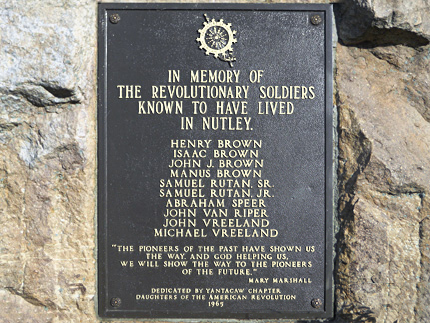
Nutley Revolutionary War Soldiers Memorial
Corner of Franklin Ave. and New St.
In front of Nutley High School
Map / Directions to the Nutley Revolutionary War Memorial
Map / Directions to all Nutley Revolutionary War Sites
This memorial which stands in front of Nutley High School pays tribute to ten Revolutionary War soldiers who lived in what is now the township of Nutley. However, Nutley did not exist at the time of the Revolutionary War. It was then a sparsely-populated area that was part of Newark, which was much larger than it is today. The area that is now Nutley incorporated as Franklin Township in 1874, and then officially changed its name to Nutley in 1902. [1]
The memorial was dedicated at a ceremony on Washington's Birthday, February 22, 1965. The ceremony began inside the High School auditorium, and then moved outside for the presentation of the bronze plaque. Among the more than 250 attendees were a number of descendants of the soldiers listed on the memorial. Harry W. Chenoweth, who was then the mayor of Nutley, spoke at the ceremony. [2]
Three of the veterans listed on the plaque — John Van Riper, Abraham Speer, and Michael Vreeland — lived in houses which are still standing in Nutley. These houses are described in the entries below on this page. [3]

Van Riper House
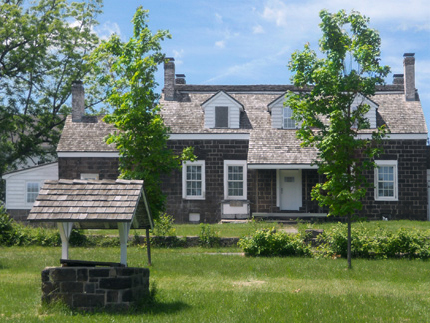
Van Riper House
491 River Rd.
Map / Directions to the Van Riper HouseMap / Directions to all Nutley Revolutionary War Sites
The Van Riper House is currently being restored, and is not open at this time.
For more information about the house and its history, see the Van Riper Restoration Trust website:
www.vanriperrestorationtrust.wordpress.com/
The Van Riper House was built in 1708 and enlarged in 1788. It was the home of John Abraham Van Riper, who served as a private in the Essex County militia during the Revolutionary War. [4]
The house is also notable for having witnessed an important moment early in the war, when George Washington and the Continental (American) Army marched past it during their 1776 retreat across New Jersey.
The Continental Army's 1776 Retreat Across New Jersey
The year 1776 was a tumultuous one for the American cause in the Revolutionary War. July 4 had seen the milestone of adopting the Declaration of Independence. But on the military side, the war had gone poorly for General George Washington and the Continental Army. They suffered a series of defeats on Long Island and Manhattan between August and September. Then on November 19-20, British and Hessian troops under the command of General Cornwallis invaded New Jersey by crossing the Hudson River from Manhattan and landing at Lower Closter Landing in Bergen County. This forced the Continental Army to evacuate their camp at nearby Fort Lee and begin a twelve-day retreat across New Jersey, with the British and Hessian troops in pursuit. (Hessians were German mercenary soldiers hired by the British to fight on their side in the Revolutionary War.)
The Continental Army's retreat took them first through Bergen County to the Passaic River. They crossed the Passaic River into Acquackanonk (now Passaic) on November 21. The next day they marched along the west side of the Passaic River through what are now Clifton, Nutley, and Belleville to Newark; this path took them past the Van Riper House along what is now River Road in Nutley. The pursuing British and Hessians followed several days later, and it is likely at least some of them passed by the Van Riper House.
The retreating Continental Army reached Newark on November 23, and remained there until November 28. From Newark, they continued their retreat southwest across the state through New Brunswick and Princeton. They arrived in Trenton on December 2, where they spent five days moving all the troops and supplies across the Delaware River into Pennsylvania. [5]
This was a desperate period for General Washington, the army, and the country. Thomas Paine famously described this period as, "These are the times that try men's souls." [6]
However, within weeks General Washington and the Continental Army would turn the tide. On Christmas night, Washington's forces crossed the Delaware River back into New Jersey to win a small but important victory the next morning at Trenton, followed eight days later with another victory at Princeton. Having revived their chances and morale, Washington's army headed to Morristown where they spent the winter. [7]
As it would throughout the rest of the Revolutionary War, New Jersey had played a pivotal role during this period, part of which involved a march through what is now Nutley.

VREELAND HOMESTEAD
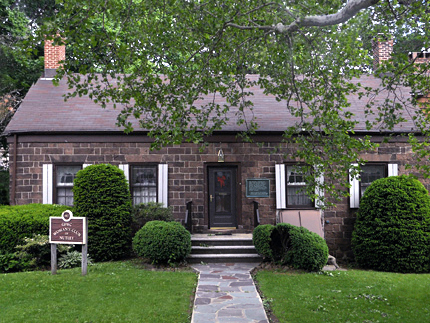
The Vreeland Homestead
Now run by the Nutley Historical Society
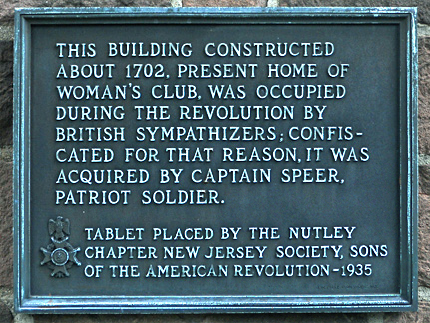
The plaque on the house, placed in 1935.
As explained below, most of the information on the sign is incorrect.
Vreeland Homestead
216 Chestnut St.
Map / Directions to the Vreeland House
Map / Directions to all Nutley Revolutionary War Sites
Contact the Nutley Historical Society for more information about tours and special events.
Vreeland Homestead [8]
The Vreeland Homestead stands between the Nutley Police Department and the entrance to Memorial Park (commonly known as the "Mud Hole"). A plaque which was placed on the building in 1935 notes its Revolutionary War significance. However, most of the plaque's information is now considered to be incorrect.
The house was built by Hendrick van Giesen, most likely circa 1751, making it nearly a quarter-century old at the start of the war in 1775. As indicated on the plaque, it was once believed that the Van Giesens who lived here were Loyalists during the Revolutionary War, and that their property was confiscated from them for this reason. (Loyalists were Americans who remained Loyal to the British in the Revolutionary War.) However, it now seems likely that the Van Giesens who lived here were not Loyalists, and that the property was never confiscated. The homestead and its surrounding eighty-acre property were in fact sold in a legal sale by Hendrick Van Giesen's brother Abraham to Captain Abraham Speer on October 6, 1783. Speer served as a captain of the Second Regiment, Essex County Militia, during the Revolutionary War.
On the day that Captain Speer purchased this house, the Revolutionary War had been officially over for several weeks, but interestingly no one in New Jersey knew it yet. On September 3, the Treaty of Paris had been signed, officially ending the Revolutionary War, although due to the slowness of ship travel across the Atlantic Ocean at that time, the news of the treaty's signing did not reach America until October 31.
Captain Speer only owned the house briefly. He quickly sold the house and twenty-seven acres of the surrounding property to his brother-in-law John M. Vreeland, who had served as a private in Captain Speer's militia company in the Revolutionary War.
The house remained in the Vreeland family until the early 1900's. The Women's Club of Nutley began renting the house In 1912, and purchased it in 1923. It was used by the Women's Club until 2012, when it was turned over to the Nutley Historical Society. It is now occasionally open to the public for special events.
Other Captain Abraham Speer House in Nutley [9]
Captain Abraham Speer owned another house in Nutley which is still standing. That house is located on Church Street near Bloomfield Ave, but it is a private home which is set back from Church Street and is not visible from the street. It is believed to have been built circa the 1760's for Abraham and his bride Emmetche Wouters by Emmetche's father. Abraham lived in the Church Street house until his death in 1834. He is buried several miles from here in the Belleville Reformed Church Cemetery.

KINGSLAND MANOR

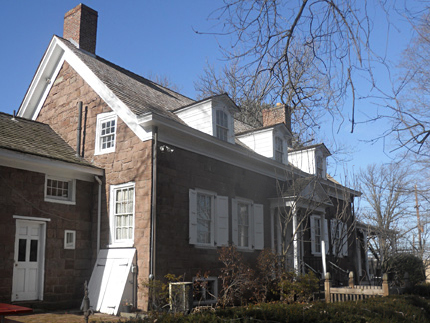
See the Kingsland Manor Facebook page for information about upcoming Events and Open Houses.
or contact KingslandManor@KingslandManor.org
Private tours can also be arranged.
Kingsland Manor [10]
Kingsland Manor is located next to Kingsland Park, overlooking the waterfalls on the Third River, which flows through the park. The oldest portion of Kingsland Manor was built circa 1768, seven years before the Revolutionary War began. The house was much smaller at that time, and in fact stood at a different location — about a mile upriver from here, near a mill in what is now Memorial Park (commonly known as the Mud Hole). Soon after that smaller version of the house was constructed at that site, it was taken apart. The pieces were then floated downriver to this site, where the house was reconstructed. The original owners of the house were James and Mary Walls. James and Mary continued to live at the house throughout the Revolutionary War years.
As described in the Van Riper House entry above, the Continental Army retreated down what is now River Road in November 1776. River Road is less than a half-mile from the Kingsland Manor, so It is likely that James and Mary Walls may have been aware of the thousands of soldiers marching by. It is also possible that some of the soldiers may have ventured off from the main road and passed by closer to the house. However, this is only speculation, because there is no recorded information about the Walls's experience of the November 1776 retreat.
When the war came to an end in 1783, the Walls still owned the house. Around 1787-1790, the house was purchased by Joseph Kingsland, who was part of a Kingsland family who had been settlers of the area that is now Lyndhurst. During the Revolutionary War, Joseph had left the country to live in Nova Scotia, which implies that he was either Loyal to the British, or he was simply neutral and wished to avoid the war altogether.
It is important to remember that many Americans were not strongly pro-Independence during the war. It has been estimated that 1/3 of the population were pro-Independence, 1/3 remained Loyal to the British, and the other 1/3 were somewhat neutral. These divisions sometimes occurred within families, including the Kingslands. While Joseph had left the country during the war, other members of the extended Kingsland family fought on the American side. Joseph's wife, Mary Outwater was the first cousin once removed of Captain John Outwater, a noted officer of the Bergen County militia during the war.
After the war, Joseph returned to the United States and moved to New York City. Joseph purchased the Kingsland Manor and approximately 23 acres of surrounding property between 1787-1790. He continued to live in New York City for several years while improvements were made to the Kingsland Manor. He and his wife moved into the Kingsland Manor in 1796. The Kingsland family continued to live here until 1909. Over that time, alterations and expansions were made to the house.
Kingsland Manor is now operated by the Historic Restoration Trust of Nutley, who open the house to the public for occasional open houses and events. The interior of the Kingsland Manor reflects all periods of its history. The house had a colorful history after its Revolutionary War-era beginnings, including that it was used as a speakeasy during Prohibition. I recommend a visit to the house when it is open, to experience firsthand the history of this Nutley Landmark. For more information about upcoming events, see the Kingsland Manor Facebook page or contact KingslandManor@KingslandManor.org.
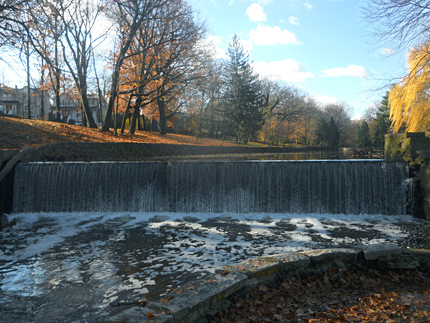
Waterfall in Kingsland Park, near Kingsland Manor

Ducks on the riverbank in front of Kingsland Manor

Source Notes:
1. ^ What is now Nutley was originally part of Newark. When Newark was established in 1666, it was a much larger area than it is today.
• Historical Map of Newark New Jersey, 1666-1916, Compiled for the 250th Anniversary Celebration by Edward S. Rankin, C.E, August 1916
Available on the Rutgers University website hereIn 1812, a portion of Newark split off, calling itself Bloomfield, which included modern-day Belleville and Nutley.
• "An act to set off and erect a new township from the township of Newark, in the county of Essex; Passed the 24th of January, 1812," Laws of the State of New-Jersey (Trenton: Revised and Published under the Authority of the Legislature, 1821) Pages 553-554
Available to be read at Google Books hereIn 1839, a portion of Bloomfield split off, calling itself Belleville, which included modern-day Nutley.
• "An act to set off the township of Belleville, in the county of Essex," Acts of the Sixty-Third General Assembly of the State of New Jersey (Camden: P. J. Gray, 1839) Pages 67-70
Available to be read at Google Books hereIn 1874, a portion of Belleville split off, calling itself Franklin. The boundaries of Franklin were that of modern-day Nutley.
• "An act to set off from the Township of Belleville, in the County of Essex, a new Township to be called the township of Franklin," Acts of the Ninety-Eighth Legislature, of the State of New Jersey (Paterson: Chiswell & Wurts, 1874) Pages 191-194
Available to be read at Google Books hereIn 1902, Franklin was officially renamed Nutley.
• "An Act to incorporate the town of Nutley, in the county of Essex," Acts of the One Hundred and Twenty-Sixth Legislature of the State of New Jersey (Trenton: J. L. Murphy Publishing Co., 1902) Page 19
Available to be read at Google Books here2. ^ "Revolutionary War Memorial Dedicated," The Nutley Sun, February 25, 1965, Pages 1 and 19
▸ Obtained from the Nutley Newspaper and Nutley History Archives digital collection at the Nutley Public Library.3. ^ This plaque was dedicated by the Yanticaw Chapter Daughters of The American Revolution in 1965
Additional details about six of the ten veterans on the plaque can be found on the Daughters of the American Revolution Genealogy Research Database: Henry Brown, John J. Brown, Samuel Rutan, Jr., Abraham Speer, John Van Riper, and John Vreeland.
Six of the veterans listed on the plaque, Henry Brown, Isaac Brown, John J. Brown, Hermanus "Manus" Brown, Abraham Speer, and Michael Vreeland, are buried at the Belleville Reformed Church and Cemetery. Hermanus "Manus" Brown, who died at the Battle of Connecticut Farms, was only recently discovered to be among the graves in the cemetery. For more information, see the following article by Mike Perrone, the President of the Belleville Historical Society:
• Michael Perrone, "Young Nutley Soldier Among Those Buried at Belleville Church," Belleville Times, July 2, 2015
Available to be read at the NorthJersey.com website here4. ^ Van Riper Restoration Trust website — Home and Narrative Statement of Significance pages
The Daughters of the American Revolution Genealogical Research System, where John Van Riper is Ancestor # A118826
5. ^ The arrival of George Washington and the Continental Army in Acquackanonk (now Passaic) on November 21 is recorded in the following letter:
• “From George Washington to William Livingston, 21 November 1776,” Founders Online, National Archives, last modified December 28, 2016, http://founders.archives.gov/documents/Washington/03-07-02-0138 http://founders.archives.gov/ documents/Washington/ 03-07-02-0138. [Original source: The Papers of George Washington, Revolutionary War Series, vol. 7, 21 October 1776–5 January 1777, ed. Philander D. Chase. Charlottesville: University Press of Virginia, 1997, pp. 195–196.]
They remained at Acquackanonk until the next morning (November 22), and proceeded through what are now Clifton, Nutley, and Belleville towards Newark. There is some uncertainty as to whether they entered Newark late on November 22, or early on November 23, but their presence in Newark on November 23 is confirmed by the following letters which Washington wrote that day which are marked as being sent from Newark.
• “From George Washington to John Hancock, 23 November 1776,” Founders Online, National Archives, last modified December 28, 2016, http://founders.archives.gov/documents/Washington/03-07-02-0139 http://founders.archives.gov/ documents/Washington/ 03-07-02-0139. [Original source: The Papers of George Washington, Revolutionary War Series, vol. 7, 21 October 1776–5 January 1777, ed. Philander D. Chase. Charlottesville: University Press of Virginia, 1997, pp. 196–198.]
• “From George Washington to William Livingston, 23 November 1776,” Founders Online, National Archives, last modified December 28, 2016, http://founders.archives.gov/documents/Washington/03-07-02-0140 http://founders.archives.gov/ documents/Washington/ 03-07-02-0140. [Original source: The Papers of George Washington, Revolutionary War Series, vol. 7, 21 October 1776–5 January 1777, ed. Philander D. Chase. Charlottesville: University Press of Virginia, 1997, p. 198.]
The pursuit of British and Hessian forces under General Cornwallis from Acquackanonk to Newark several days behind the Continental Army is supported by the following contemporary documents. Each of these documents provides fragments of information. There is some confusion among the documents as to the path they took, and whether they travelled in one column or two. Despite the uncertainty, it appears likely to me that at least a portion of the British and Hessian forces would have gone by what is now River Road past the Van Riper House.
• “From George Washington to John Hancock, 30 November 1776,” Founders Online, National Archives, last modified February 21, 2017, http://founders.archives.gov/documents/Washington/03-07-02-0168 http://founders.archives.gov/ documents/Washington/ 03-07-02-0168. [Original source: The Papers of George Washington, Revolutionary War Series, vol. 7, 21 October 1776–5 January 1777, ed. Philander D. Chase. Charlottesville: University Press of Virginia, 1997, pp. 232–234.]
• Captain Johann Ewald, Translated and edited by Joseph P. Tustin, Diary of the American War — A Hessian Journal (New Haven and London: Yale University Press, 1979) Page 22
• "Journals of Liet.-Col. Stephen Kemble," The Kemble Papers — Vol. 1 — 1773 -1789 in Collections of the New-York Historical Society for the Year 1883 (New York: New York Historical Society, 1884) Pages 101-102
Available to be read at the Internet Archive here• Harry Miller Lydenberg, editor, Archibald Robertson, Lieutenant-General Royal Engineers: His Diaries and Sketches in America, 1762–1780 (New York Library and Arno Press,Inc., Reprint Edition 1971) Pages 113-114
Available to be read at the Hathi Trust website here• Carl Leopold Baurmeister, Translated and annotated by Bernhard A. Uhlendor, Revolution in America. Confidential Letters and Journals, 1776-1784, of Adjutant General Major Baurmeister of the Hessian forces (Rutgers University Press: New Brunswick, 1957) Pages 72-73
For more details and accompanying source notes about the events in other towns which are mentioned in the first three paragraphs of this entry, see the Fort Lee, Alpine, Passaic, Belleville, Newark, and New Brunswick pages of this website.
6. ^ "These are the times that try men's souls" is the opening sentence of Thomas Paine's The Crisis. (Also known as The American Crisis.)
Paine was with the Continental Army during the 1776 retreat across New Jersey; he is believed to have begun writing The Crisis during the retreat while the Continental Army was at Newark, in the days following their marching through what is now Nutley.
▸ For more information about Thomas Paine, including the topic of whether he began writing The Crisis in Newark, see the Thomas Paine Monument entry on the Morristown page and the accompanying Morristown Source Note #34.7. ^ For more details and accompanying source notes about these events, see the Hopewell Township, Trenton, Princeton, and Morristown pages of this website.
8. ^ Much of the information in this entry about the history of the Vreeland Homestead was drawn from John Simko, Museum Director of the Nutley Museum, in conversations on February 8 and 13, 2017. This included a tour of the Vreeland Homestead he gave me on February 13, and documents which he shared with me.
I would like to thank John for his time and assistance.Other documents consulted include:
• Historic American Buildings Survey for the Vreeland Homestead
Available at the Library of Congress website here• National Register of Historic Places Nomination Form for the Vreeland Homestead
Available at the National Park Service website here• A 2013 article written by John Simko about the Vreeland Homestead, entitled "A Brief History, Updated" can be read at the Nutley Historical Society website here
9. ^ Much of what is recorded about Captain Abraham Speer, his family, and the Church Street house appeared in two books, one published in 1907 and the other in 1961. A lot of the information in these books is folklore, so it can be hard to distinguish how much of it is accurate. My own inclination is to be skeptical about folklore which is not supported by known documentation. But for those who would like to read the accounts from these books, see:
• Elizabeth Stow Brown, The History of Nutley, Essex County, New Jersey (Nutley: The Woman's Public School Auxiliary, 1907) Page 32-36
Available to be read at the Internet Archive here• Ann A. Troy, Editor, Nutley, Yesterday • Today (Nutley Historical Society, 1961) Pages 21-22 (In the "Over Povershon Hill Came a Stager to Found a Clan" chapter, written by Frank Speer), and Pages 182-183 (In the "Early Homes" chapter, written by Ann A. Troy)
Regarding Abraham Speer's Revolutionary War military service:
• William S. Stryker, Official Register of the Officers and Men of New Jersey in the Revolutionary War (Trenton: Wm. T. Nicholson & Co., 1872) Page 411
Listing reads, "SPEER, ABRAHAM. Captain, Second Regiment, Essex, May 28th, 1777"
Available to be read at the Internet Archive here• The Daughters of the American Revolution Genealogical Research System, where Abraham Speer is Ancestor # A203378
10. ^ Much of the information in this entry about the history of the Kingsland Manor and the Walls and Kingsland families was drawn from conversations with Kingsland Manor Trust Vice President Leon Kish on February 16, 18, 19, 20 and 21, 2017. This included a tour of the Kingsland Manor he gave me on February 19, and documents which he shared with me.
I would like to thank Leon for his time and assistance.
Additional information regarding Revolutionary War service by members of the extended Kingsland family:
• William S. Stryker, Official Register of the Officers and Men of New Jersey in the Revolutionary War (Trenton: Wm. T. Nicholson & Co., 1872) Pages 227 and 655
▸ Lists five Kingslands as having served in the Essex County Militia (Page 655), and one Kingsland having served in the Continental Army (Page 227)
Available to be read at the Internet Archive here• Two Kingslands who fought in the Revolutionary War are buried in the Belleville Reformed Church Cemetery.
• Edmund Kingsland of Morris County signed Articles of Association in 1776. He is listed as an ancestor in the Daughters of the American Revolution Genealogical Research Database for "Patriotic Service" for having signed these Articles of Association.
▸ The text of these Articles of Association and the list of signers is reprinted in:
John L. Kanouse, "Pequannock Township," in History of Morris County, New Jersey (New York: W. W. Munsell & Co., 1882) Page 275
Available to be read at the Internet Archive here